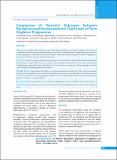Please use this identifier to cite or link to this item:
https://hdl.handle.net/20.500.14356/1505Full metadata record
| DC Field | Value | Language |
|---|---|---|
| dc.contributor.author | Bajracharya, Nishma | - |
| dc.contributor.author | Dangal, Ganesh | - |
| dc.contributor.author | Poudel, Rekha | - |
| dc.contributor.author | Tiwari, Kenusha Devi | - |
| dc.contributor.author | Bharati, Sonu | - |
| dc.contributor.author | Maharjan, Ostha | - |
| dc.contributor.author | Maharjan, Sunita | - |
| dc.contributor.author | Karki, Aruna | - |
| dc.contributor.author | Pradhan, Hema Kumari | - |
| dc.contributor.author | Shrestha, Ranjana | - |
| dc.contributor.author | Bhattachan, Kabin | - |
| dc.date.accessioned | 2023-05-14T10:14:26Z | - |
| dc.date.available | 2023-05-14T10:14:26Z | - |
| dc.date.issued | 2020 | - |
| dc.identifier.citation | BajracharyaN., DangalG., PoudelR., TiwariK. D., BharatiS., MaharjanO., MaharjanS., KarkiA., PradhanH. K., ShresthaR., & BhattachanK. (2021). Comparison of Perinatal Outcomes between Borderline and Normal Amniotic Fluid Index in Term Singleton Pregnancies. Journal of Nepal Health Research Council, 18(4), 709-713. https://doi.org/10.33314/jnhrc.v18i4.3051 | en_US |
| dc.identifier.issn | Print ISSN: 1727-5482; Online ISSN: 1999-6217 | - |
| dc.identifier.uri | http://103.69.126.140:8080/handle/20.500.14356/1505 | - |
| dc.description | Original Article | en_US |
| dc.description.abstract | Abstract Background: Amniotic fluid provides necessary fluid and growth factors for normal development of fetal lungs, cushions the umbilical cord from compression and protects the fetus. This study aims to compare the perinatal outcome between pregnancy with borderline and normal Amniotic Fluid Index that provide greatest chance for appropriate safe delivery with least maternal fetal and neonatal risk. Methods: A total of 94 singleton full term pregnant women were included in the study-at Kathmandu Model Hospital from February to August 2020. Forty Seven women each with Amniotic Fluid Index 5-8 cm was taken as borderline oligohydramnios group and Amniotic Fluid Index 8.1-24 cm was taken as normal group. Ultrasonography was taken as the medium for measuring Amniotic Fluid Index. Results: The rate of intra-partum fetal distress, meconium-stained amniotic fluid, low birth weight and neonatal intensive care unit admission were not statistically significant between the two groups while rate of cesarean section was noted to be 76.6% in exposed groups as compared to 44.7% among women with non-exposed normal group [RR=1.71; 95%CI: 1.2-2.44 p=0.006]. Conclusions: We concluded that in cases of borderline oligohydramnios there was higher risk of operative delivery. Keywords: Adverse perinatal outcome; amniotic fluid; borderline oligohydramnios; meconium-stained amniotic fluid | en_US |
| dc.language.iso | en | en_US |
| dc.publisher | Nepal Health Research Council | en_US |
| dc.relation.ispartofseries | Oct-Dec, 2020;3051 | - |
| dc.subject | Adverse perinatal outcome | en_US |
| dc.subject | Amniotic fluid | en_US |
| dc.subject | Borderline oligohydramnios | en_US |
| dc.subject | Meconium-stained amniotic fluid | en_US |
| dc.title | Comparison of Perinatal Outcomes between Borderline and Normal Amniotic Fluid Index in Term Singleton Pregnancies | en_US |
| dc.type | Journal Article | en_US |
| local.journal.category | Original Article | - |
| Appears in Collections: | Vol. 18 No. 4 (2020): Vol. 18 No. 4 Issue 49 Oct-Dec 2020 | |
Files in This Item:
| File | Description | Size | Format | |
|---|---|---|---|---|
| 3051-Manuscript-20005-1-10-20210122.pdf | Fulltext Download | 224.98 kB | Adobe PDF |  View/Open |
Items in DSpace are protected by copyright, with all rights reserved, unless otherwise indicated.
